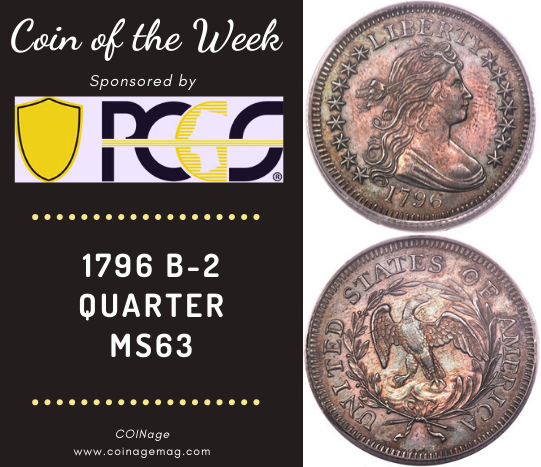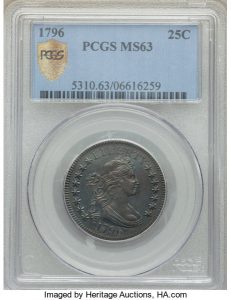
By Antoinette Rahn
Sometimes when a new idea comes to the table, it’s met with a less than exuberant response. In turn, the same concept or item may strike the fancy of the majority at a different time, in a different manner, and for a host of different reasons.
In my understanding and humble opinion, that’s part of the story surrounding the 1796 B-2 quarter. First, it’s critical to note that this is a one-year-only type of coin, as explained by numismatic expert David Hall for PCGS’ Coin Facts.
It’s a stretch, but if you were to consider a pop culture comparison, you could liken the 1796 quarter to a one-hit-wonder in music. Just like a song that would enjoy extreme popularity immediately, and then fade, but proceed to linger in the collective music subconscious for years to come, but never be joined by another hit from the same musician, the 1796 quarter shares a somewhat similar path.
Ok, maybe that was a wild stretch for a comparison, but I’m guessing that at least a couple one-hit-wonder songs came to mind as you read that analogy. I see you there, playing “Safety Dance” by Men Without Hats on repeat. But, I digress.
First and Only
As the history analogs reveal, while the 1796 quarter was the first of its kind to be officially issued by the U.S. Mint, it does not mark the inception of the quarter dollar pattern. As explained in the lot description for the 1796 B-2 Quarter, MS63 PCGS featured in Heritage Auction’s upcoming Long Beach Expo U.S. Coins Signature Auction, the first quarter dollar patterns had been struck in 1792 by Joseph Wright, one of the earliest designers of U.S. coins.

The coin holds a couple ‘claims to fame’ if you will. According to information presented by Hall in the Coin Facts report, it is the representative of a U.S. quarter struck during the 18th century. Also, in the same PCGS Coin Facts report, numismatic expert P. Scott Rubin explains that the 1796 quart is the only U.S. coin that was not issued the year after its initial issuance.
There may be a few questions that come to mind after considering those factors, but the most common seems to be, why was it only minted for one year, with a mintage of merely 6,146? The lot description for the 1796 quarter featured in the Heritage Auction’s sale, cites Steve M. Tompkins reference Early United States Quarters, explaining that the key reason for this was because it was depositors who informed the U.S. Mint about the denominations they wanted. Also, at this time, the Spanish colonial two reales denomination was used in commerce within the U.S., leading to questioning and dispute about whether a U.S. quarter was needed, or even wanted. This situation contributed to the one-and-done lifespan of this specific quarter dollar. As Rubin explained, it would be another eight years before the second date quarter dollar was issued.
Modern Appreciation
Fast forward to the 21st century, and the unneeded and seemingly unwanted 1796 quarter dollar is always a “belle” of any numismatic “ball” (auction, sale, discussion) where it is represented. According to Rubin’s report, less than 50 examples of 1796 quarters have been presented for sale at auction in the past decade or so.
In addition to its intriguing history, the 1796 quarter set to cross the virtual auction block through Heritage Auctions presents in Mint State grade, with shades of green-gold, peach, violet, and gunmetal-blue, and a luster that appears sem-ireflective.
So, the next time you are considering something that may seem ahead of its time or even unnecessary, remember the 1796 quarter.
For more information about PCGS’ services and mission, visit https://www.pcgs.com/, and for more information about Heritage Auction’s Long Beach Expo U.S. Coins Signature Auction www.ha.com.
About PCGS: Professional Coin Grading Service (PCGS) represents the industry standard in third-party certification. Visit www.pcgs.com for more information.















